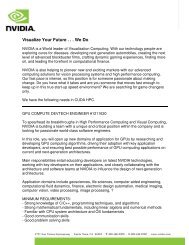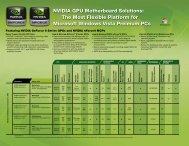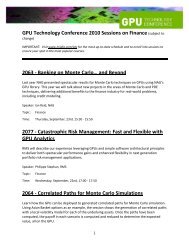NVIDIA QUADRO G-SYNC II
NVIDIA QUADRO G-SYNC II
NVIDIA QUADRO G-SYNC II
Create successful ePaper yourself
Turn your PDF publications into a flip-book with our unique Google optimized e-Paper software.
<strong>NVIDIA</strong> Quadro G-Sync <strong>II</strong> User Guide<br />
Frame Counter<br />
The implementation provides a universal counter, or frame counter, among<br />
all systems that are locked together by swap groups/barriers. It is based<br />
on the internal synchronization signal which triggers the buffer swap.<br />
� To obtain the current frame count, call<br />
wglQueryFrameCountNV(),glxQueryFrameCountNV()().<br />
� To reset the frame count back to zero, call,<br />
wglResetFrameCountNV(),glxResetFrameCountNV()().<br />
In a system that has a Quadro G-Sync <strong>II</strong> device installed<br />
and enabled, ResetFrameCountNV() succeeds only when<br />
the frame lock device is confi gured as a master device.<br />
Confi guring for Swap Sync<br />
Confi guring Swap Groups<br />
59<br />
You can assign an OpenGL window to a swap group. There<br />
is a maximum number of allowable swap groups that can be<br />
created for any particular implementation. With the current<br />
hardware, the maximum number of swap groups is one.<br />
� To determine the maximum swap group number, call<br />
QueryMaxSwapGroupsNV()<br />
� To assign a window to a swap group, call<br />
JoinSwapGroupNV()<br />
and specify the swap group number.<br />
If rendering surface is already a member of a different group, it is<br />
implicitly removed from that group. If the swap group number is zero,<br />
the rendering surface is removed from the current group.<br />
To query the current swap group, call QuerySwapGroupNV().

















